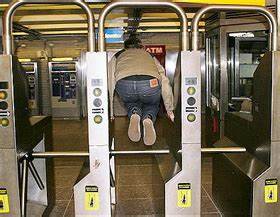
by James A. Bacon
Thirty-four percent of all Washington Metropolitan Area Transit Authority bus riders are not paying their fares, reducing revenues by $10 million in the second half of 2021 alone, reports The Washington Post. That’s up from 17% in unpaid fares two years previously.
Bacon’s Rebellion readers may be reassured to know that 42% of all Metrobus fare-jumping incidents took place in D.C., 34% in Maryland, and only 6% occurred in Virginia. The WaPo article does not compare those numbers to Metrobus ridership, however, so it’s not clear that Virginia riders are more law-abiding.
Whatever the case, some local government representatives view fare evasion as a social issue stemming from poverty rather than criminality. The Washington, D.C., City Council is now discussing a proposal to give city residents $100 in monthly fare credit.
“Most people skipping fares are doing so because they can’t afford to pay their transportation costs,” said Councilman Charles Allen in a statement. “We can help ease that pain a little.”
Allen’s statement is remarkable: it packs some very big assumptions into a short sentence.
Let’s start with his assertion that the doubling of fare jumping can be attributed to the scofflaws’ inability to pay. Allen proffers no empirical data to back up that statement, at least nothing reported by The Washington Post. The crime-stems-from-poverty shibboleth is repeated endlessly with no critical examination and is deemed a proposition that needs no proof.
Many people lost their jobs during the COVID epidemic, to be sure, but federal COVID relief also showered Americans with cash. If you’re going to make the claim that fare jumpers are reacting to adverse economic circumstances, at least provide some evidence to back it up. Show us that residents of Washington, D.C., suffered a loss of income even after the flood of COVID relief last year. And while you’re at it, demonstrate that the people jumping Metrorail turnstiles or brushing past bus fare boxes are those most strapped for cash.
Alternatively, let us explore an equally plausible explanation for fare jumping: It reflects an increasing contempt for society’s rules and norms on the part of the fare jumpers, as well as the condoning of their behavior by politicians and intelligentsia on the grounds that those rules and norms are expressions of systemic racism.
I offer that as a conjecture, freely admitting that I have no proof as to the thinking of the fare jumpers. But I can imagine a way to verify or falsify my proposition: let’s see what happens as economic conditions return to a pre-COVID normal. As joblessness drops and financial hardship recedes, will fare jumping recede in lockstep?
If unpaid fares decline from 34% back to 17% of Metro bus riders, then we can logically infer that, yes, there was a strong connection between economic hardship and fare jumping. If the practice does not recede — if, to the contrary, fare jumping persists at its current high level or increases yet more — we can conclude that some other explanation is called for.
D.C. City Council could complicate any analysis if it enacts the $100 in monthly free fare credits, which would render meaningless any fare-jumping comparisons between COVID and post-COVID years. But we could still compare the practice in Maryland and Virginia, where no such giveaways are contemplated.
My prediction is that fare-jumping will stay stubbornly and persistently high. If the numbers don’t bear me out, I’ll be willing to reassess my conjecture. If the numbers back me up, will those who insist that fare-jumping stems from poverty be willing to re-examine their beliefs? Here’s another prediction: no, they won’t.

Leave a Reply
You must be logged in to post a comment.